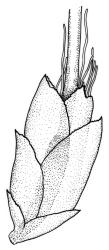Lin’s (1983) synopsis of Orthorrhynchium included two species: O. elegans and O. balansaeanum, with the latter restricted to New Caledonia. The synopsis was appended to Lin’s revision of the Phyllogoniaceae, from which he excluded the present genus. Lin’s intra-specific treatment of O. elegans distinguished four subspecies, largely on the basis of overlapping quantitative characters. Lin’s proposed subspecies (summarised in his table 7) are not convincing and they are not accepted here, given the degree of continuous variation of O. elegans in the N.Z. portion of its range. Material of O. balansaeanum has not been available for study.
Lin (1984) excluded from Orthorrhynchium a widespread tropical Pacific species which has been termed O. cylindricum (Lindb.) Broth. This is a species of both obscure family relationships and confusing nomenclature, which was discussed by both Whittier (1976, p. 253) and Norris & Koponen (1987, p. 211). Norris and Koponen followed Isoviita (1986) and named this species Cryptogonium phyllogonioides (Sull.) Isov.
I concur with Lin (1984) and Norris & Koponen (1987) that C. phyllogonioides (Sull.) Isov. is not closely allied to O. elegans. Material of C. phyllogonioides differs from O. elegans by many features including: leaves inserted in four rather than two ranks (but still appearing distichous) and with unequal conduplicate portions, undifferentiated median cells in the leaf apex, differentiated alar cells, and by the presence of numerous, filamentous, and easily observed pseudoparaphyllia.
Cryptogonium phyllogonioides has been found at two localities in the Kermadec Is by P. de Lange who described it (in herb. AK 325647!) as having an "upright growth habit" in contrast to the prostrate growth form of O. elegans. The Kermadec collections were growing on wind-thrown Metrosideros and around tree roots over a large boulder in an ephemeral stream bed. This predominantly Polynesian and Melanesian species is at the southern fringe of its distribution in the Kermadec Is, and its occurrence on the main islands of N.Z. is considered unlikely. It is neither illustrated nor discussed further here; descriptions and illustrations can be found in the publications mentioned above.
| Category | Number |
|---|---|
| Indigenous (Non-endemic) | 1 |
| Total | 1 |
Orthorrhynchium elegans subsp. tumidum Lin is based on a single N.Z. collection of dubious locality, collector, and date (but Lin (1983) suggested it is probably a Berggren collection). Lin’s selection of a holotype of dubious provenance complicates the status of this taxon, which is neither accepted nor placed in synonymy here.




